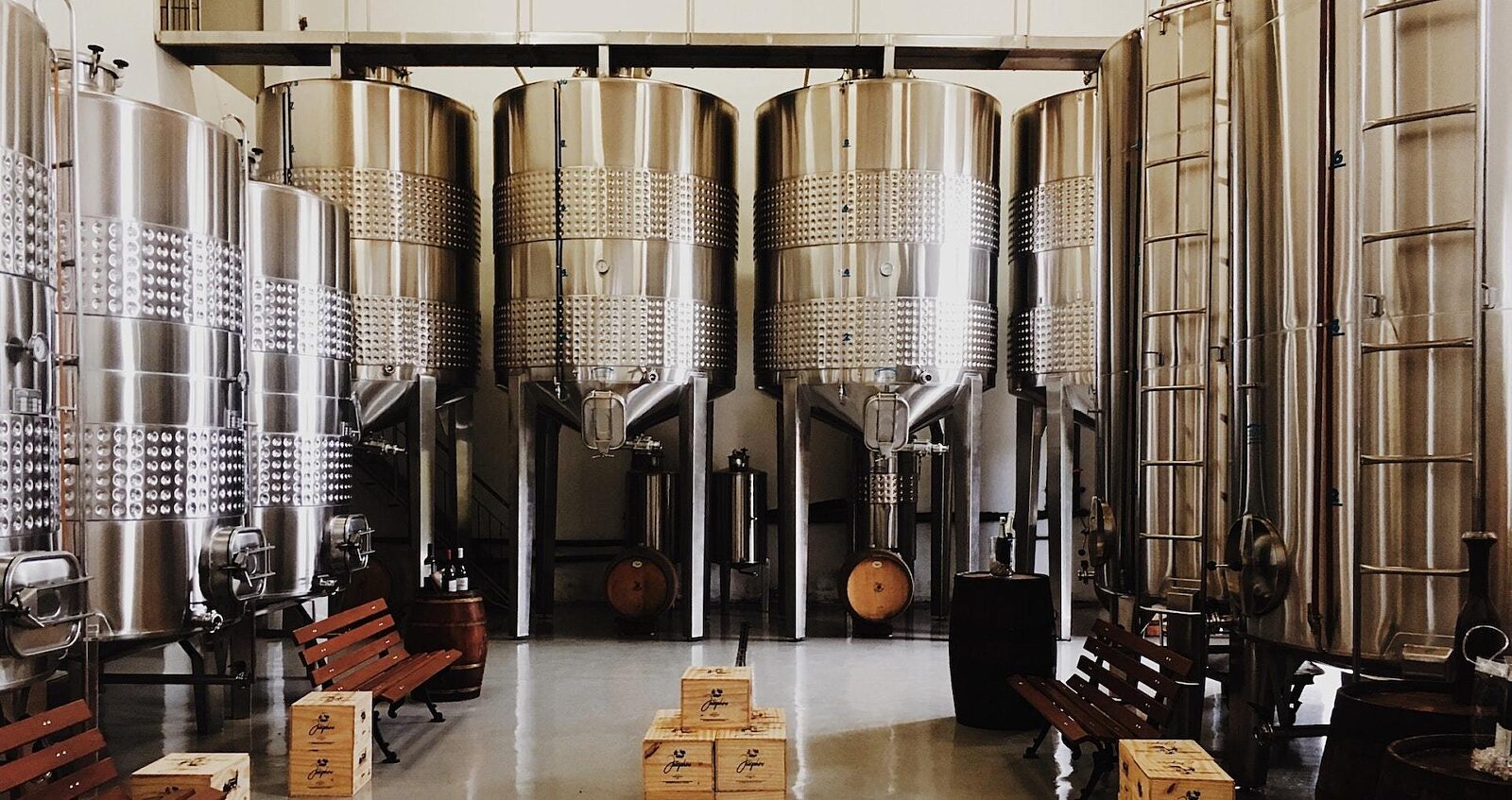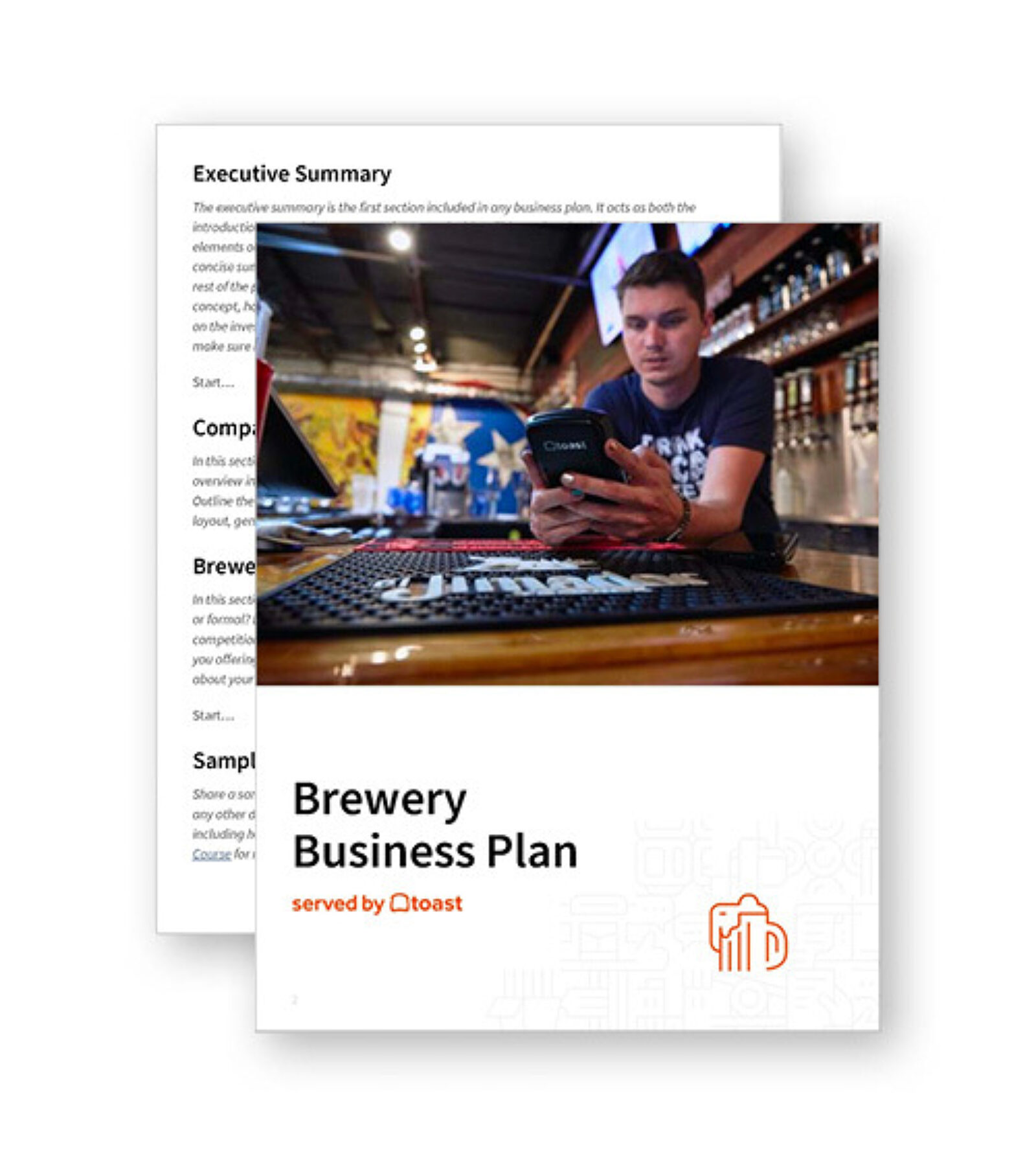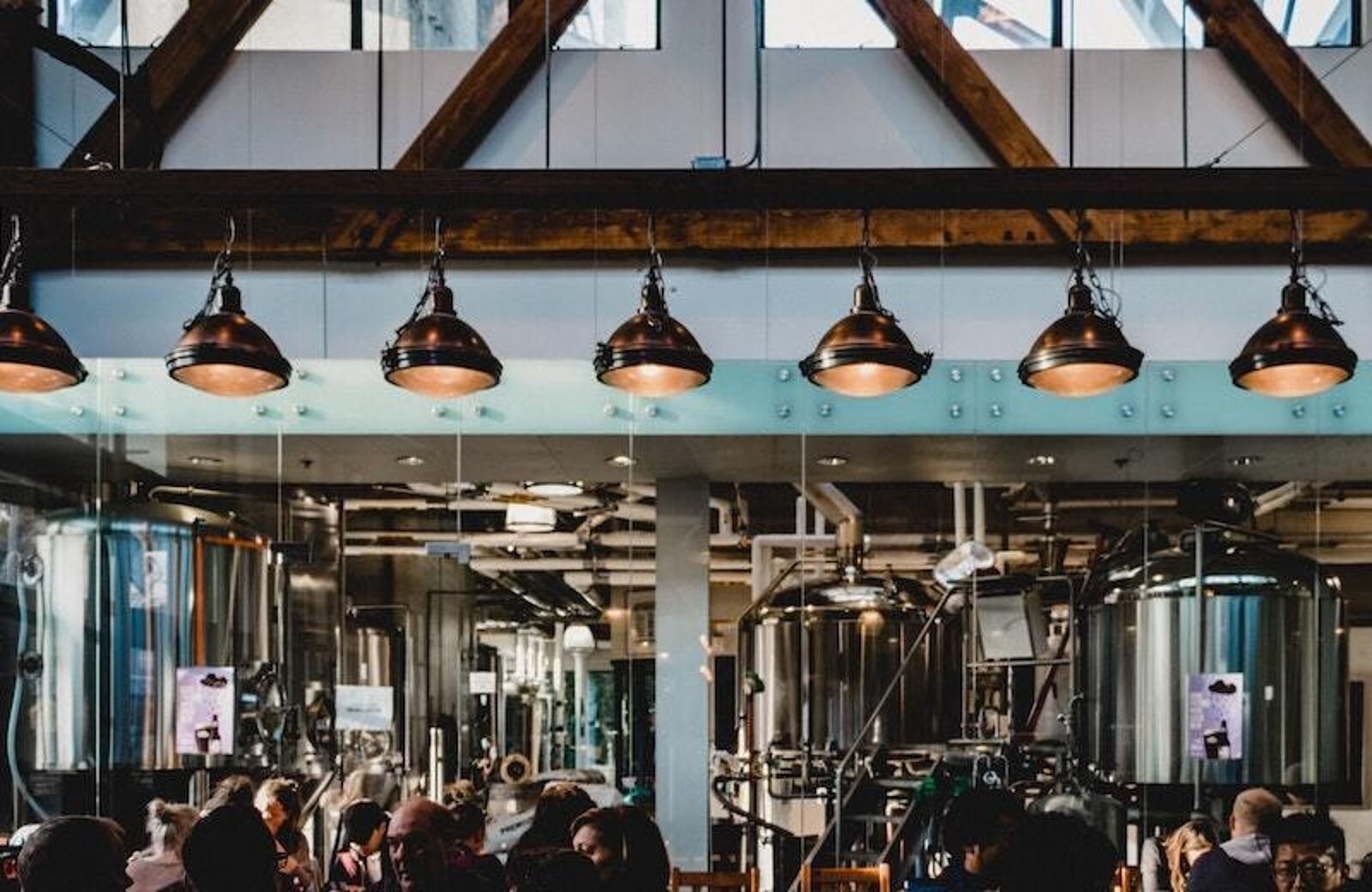
How To Write a Brewery Business Plan
A brewery business plan helps you make sense of this complex — but rewarding! — business model, while helping you attract brewery investors.
Tyler MartinezAuthor


Brewery Business Plan Template
Use this free template to easily create a great business plan that organizes your vision and helps you start, grow, or raise funding for your brewery.
Get free downloadIn the 90s and early 2000s, microbreweries started popping up all over the country. By the 2010s, craft beer madness was in full swing, with beer aficionados flocking to their local breweries to taste their seasonal wares. 15 years later, breweries have continued bringing in crowds of beer aficionados, and the craft beer industry keeps growing.
Writing a Business Plan for Breweries
Many would-be brewery owners go into it as a passion project, perhaps inspired by experience working in craft breweries, the brewing industry, or in-home brewing. It’s a potentially lucrative and profitable, if complex, business model — and in order to keep operations in order from the very beginning, you need a strong brewery business plan.
Whether you're dreaming of an open-air beer garden, a brewing company closed to the public, an industrial taproom space with cans piled high, or just a restaurant space with onsite brewery equipment, starting a brewery requires a roadmap to guide you through every step of your venture, from development to distribution.
Why You Need a Brewery Business Plan
Breweries require a complex sequence of licenses, permits, leases, and financing just to get started. There’s a lot of moving pieces, from accounting to brewing beers to renting space to finding a POS that works with complex brewery operations. A business plan will let you get all the details sorted while simultaneously acting as a way to entice potential partners and investors.
A business plan will also prompt you to consider the market for high-quality craft beers in your location and how your brewery restaurant will fit into that market. Are you offering a unique experience to customers or are you hoping to hold your own in a robust local craft brewery scene? What’s going to be your competitive advantage?
Brewery Equipment Checklist
Opening or upgrading a brewery? Don't miss any essential equipment! Download our free, comprehensive Brewery Equipment Checklist.

Elements of a Brewery Business Plan
Executive Summary
The first section of the business plan is an executive summary, which is a concise introduction to the concept and goals of your brewery. Use this section to introduce key elements of your business, such as the vision for the product, your mission statement, key information about the brewery space, and the distribution market.
As you write the executive summary, imagine the investors and partners that you want this plan to attract. How might you catch their attention, get them interested in your concept, and convince them to keep reading? Craft breweries became extremely popular in the early 2010s, with new breweries opening all over the country. How will your successful brewery attract a unique share of the consumers or compete with other local brands?
Are you an experienced entrepreneur trying to invest in a microbrewery business? Or are you an experienced brewer and hospitality pro trying your hand at running your own brewery?
Company Overview
The company overview works with the executive summary to provide an introduction to the rest of your business plan, but the company overview is more practical than creative, covering the nuts and bolts of your business.
Use this section to define the type of brewery and restaurant combination you envision — are you opening a microbrewery? A brewpub? A brewery plus restaurant? Will you serve food or partner with food trucks onsite? Will you forego food and just provide bags of chips?
What will your location look like? Many convert their extra warehouse space into miniature arcades or provide lawn games like cornhole for guests to enjoy while they drink at the brewery. The focus is always on the brews, but offering an experience gets people to visit and stay awhile, increasing the brewery’s on-premises sales potential.
State what kind of legal structure your business will operate as — LLC? Sole proprietorship? Corporation? — and explain the proposed ownership structure and how your potential investors will fit within it.
Define your product, the brewing process, the supply chains you’ll rely on, and how your product will stand out in the somewhat bloated beer industry.
Consider including introductory information about roles you’ll need to fill, as well as your vision for the customer’s experience. You’ll also want to include information about potential customers, the demographics you hope to appeal to, and how you plan to reach them.
Include a summary of financial projections. Like any startup, you’ll be making educated guesses here, but try to cover all potential factors that could impact your income statements and cash flow statements in the first year and beyond.
Team and Management
The staffing needs for your brewery are unique to the business you’re building, and the role you see yourself filling within the business. Are you a brewmaster who needs funding? Will you be an owner and manager, spending all your time doing hands-on work and managing employees? Or will you hire a GM and focus your attention on the financial side of things?
Consider, too, the staffing needs of a brewery or restaurant depending on the scale of your operation. You might start by brewing a couple of drafts in a warehouse and scale up – and need very few employees – or jump into a brewery and taphouse that requires a full management team, kitchen, and front-of-house staff.
There are so many types of breweries, and just as many team structures to go along with them. Explain how you plan to find and train your team, and what traits you’ll look for in the most indispensable roles.
Sample Menu
Outline the kinds of brews you plan to craft and serve, and the kinds of food you’ll offer, if any. The combination of types of beers and types of food served are what will bring customers back time and time again, so use a sample menu to show investors what your brewery will offer. There are so many types of beers to choose from, from lagers to IPAs, so choose your niche.
Consider building your beer and food menu on a theme: if you plan to brew mostly Belgian-inspired beers, you might consider accompanying them with crispy french fries with mayo, shrimp croquettes, mussels with fries, and waffles.
Discuss your pricing strategy and include prices on your sample menu to show potential investors how much you’ll be able to bring in on an average check.
Market Analysis: Target Market, Location, and Competition
A market analysis is crucial to prove your brewery will have what it needs to be successful. The market analysis is about three key factors: target consumer, location, and competition. Provide research-backed information in your market analysis to really impress potential investors or partners.
In 2021, the US Brewers Association reported there were over 9000 breweries in the country, including over 3400 brewpubs, over 3800 taprooms, over 2000 microbreweries, and over 200 regional craft breweries.
Do a competitive analysis of your city or town: how many breweries of each kind exist within a reasonable radius? Are any very similar to the concept you plan to create? How will you improve on what they already do?
If there isn’t yet a local craft brewery in your area, is there clientele that would visit one? Are you in the middle of a vibrant craft brewer scene but have a unique product that will appeal to the established consumer base? Will you plan to collaborate with existing breweries?
Market trends vary too — double IPAs have gone up and down and up again in popularity. What’s big now, and how will you stay ahead of trends?
Outline your target market, including the demographics you hope to appeal to, and how your location and product will help you reach them.
Brand and Marketing Plan
Marketing for your brewery includes more than just eye-catching label designs, and your potential investors and partners will want to know you’ve thought through how you’ll reach new customers — and keep them coming back. Which channels will you use in your brewery marketing strategy? Social media is important, and email marketing can be a game-changer — how will you implement them?
Develop a coherent vision for your brand that both matches the spirit of your company’s values and will be attractive to your target customers. Plan to take advantage of social media to make your customers aware of your brand and craft a cohesive and memorable online presence.
Blue Mountain Brewery is a company based in Afton, VA, and they rent the inn and venue at their picturesque brewery. Their branding is bright and brimming with local flair, ensuring brand recognition and creating a cohesive aesthetic that can be translated to their product labels for distribution to the surrounding area.
Branded Graphics
One of the most exciting aspects of planning to market your brewery is working with designers to create graphics that convey your brand to potential investors and eventually customers. Think about how your logo will represent the ethos of your brewery and how it will influence the customer’s experience of your brand.
Even if you envision scaling up to regional or national distribution, don’t shy away from building a memorable, locally influenced brand. Beer aficionados across the country will love to collect your cans, especially if they clearly represent where the beer is made.
Restaurant Marketing Plan
Create a marketing plan that'll drive repeat business with this customizable marketing playbook template and interactive calendar.

Business Operations
The business operations section includes information about everything from the daily routine of the brewery to the chain of command and management structure. Consider including information about sales and inventory, your onsite seating plan, your point of sale (POS) system, accounting, and the supply chain for your beer's ingredients.
Talk about your distribution plan: Some breweries opt to only sell their beer locally — like Alchemist Beer in Stowe, Vermont where beer lovers travel to to buy their famous Heady Topper beer. Others make enough local craft beer to warrant national distribution in beer stores and bars.
A brewery is a complex business model: unlike restaurants, you’re not just selling food and drinks — you’re also producing the drinks en masse, from scratch. Outline the beer production process thoroughly, including the team members you’ll need, and explain how your brewing operation will fit into the rest of your day-to-day taproom operations.
The business operations section will act as the north star for your operations on a daily, weekly, monthly, and quarterly basis – don’t spare any details. This is the section you’ll fall back on to answer any questions from investors or partners.
Financing and Loans
Whether you’re starting a brewery based on your passion for great pilsners or because your friends convinced you to invest in opening a local brewery so they can hang out there, you’ll likely need to secure some additional funding to cover startup costs before you start bringing in revenue. It’s crucial to carefully consider your finances and prepare to apply for any necessary lines of credit or loans.
This financing guide is a valuable resource: look through it to learn about funding options from brick-and-mortar banks, alternative loans, Small Business Association (SBA) loans, merchant cash advances, business lines of credit, crowdfunding, asking family or friends, commercial real estate loans, equipment financing, and purchase order funding.
Once you have a concrete plan to fund your brewery, provide potential investors with information about other partners and detailed financial plans with projections of profit and expenses of your business. Provide ways to engage: do they want to be a part-owner, or just buy equity in the business? Can they provide a personal loan? Walk through how they might be able to help financially, and what they’d get in return.
Sales Forecasts and Operating Expenses
The operating expenses of a brewery include the costs of brewing, bottling, and kegging equipment, hops, grains, labor, insurance, licenses, rent, marketing, food — the list goes on, and should be balanced against your sales forecasts.
It's typical to include a break-even analysis in this section of your business plan, which compares the sales required to break even with the cost of expenses each month. Investors will be interested in the potential for profit and loss in order to assess the risk of contributing to your business, but a profit and loss statement for a business that isn’t open yet requires that you make some informed projections.
A cash flow analysis shows investors that the company will be able to support itself without additional investments by detailing planned spending on labor, supplies, and operations.
How to Present Your Brewery Business Plan
As you write and edit your plan, start memorizing the key points and takeaways so you're ready to talk about it at any time. Remember that the way you talk about your business should be tailored to the situation you find yourself in — an elevator pitch at a networking event, a full presentation with a slide deck, excel sheets, and accompanying binders at a formal meeting.
Send your business plan to investors and banks far and wide – put your concept and plan in the hands and minds of as many people as possible.
Once you secure a meeting with a potential investor or partner, you’ll want a more detailed presentation that presents all the key elements of your business plan. Lean into the why of your business: how will your brews add to the beer landscape? How will your brewery impact the community?
It’s good to anticipate potential questions and prepare answers for questions you encounter for the first time. When networking, be honest and genuine, even if you don’t have a ready answer for each question that comes your way – investors will be interested in your charisma and honesty just as much as your ability to build a detailed plan.
Bar and Lounge POS Comparison Tool
A free, customizable Bar and Lounge POS Comparison Tool to research and compare point of sale systems in one Excel spreadsheet or editable PDF.

Related Brewery Resources
Brewery Business Plan Template
Use this free template to easily create a great business plan that organizes your vision and helps you start, grow, or raise funding for your brewery.

Is this article helpful?
DISCLAIMER: This information is provided for general informational purposes only, and publication does not constitute an endorsement. Toast does not warrant the accuracy or completeness of any information, text, graphics, links, or other items contained within this content. Toast does not guarantee you will achieve any specific results if you follow any advice herein. It may be advisable for you to consult with a professional such as a lawyer, accountant, or business advisor for advice specific to your situation.
Read More
Subscribe to On the Line
Sign up to get industry intel, advice, tools, and honest takes from real people tackling their restaurants’ greatest challenges.



